#gerald eichstädt
Text
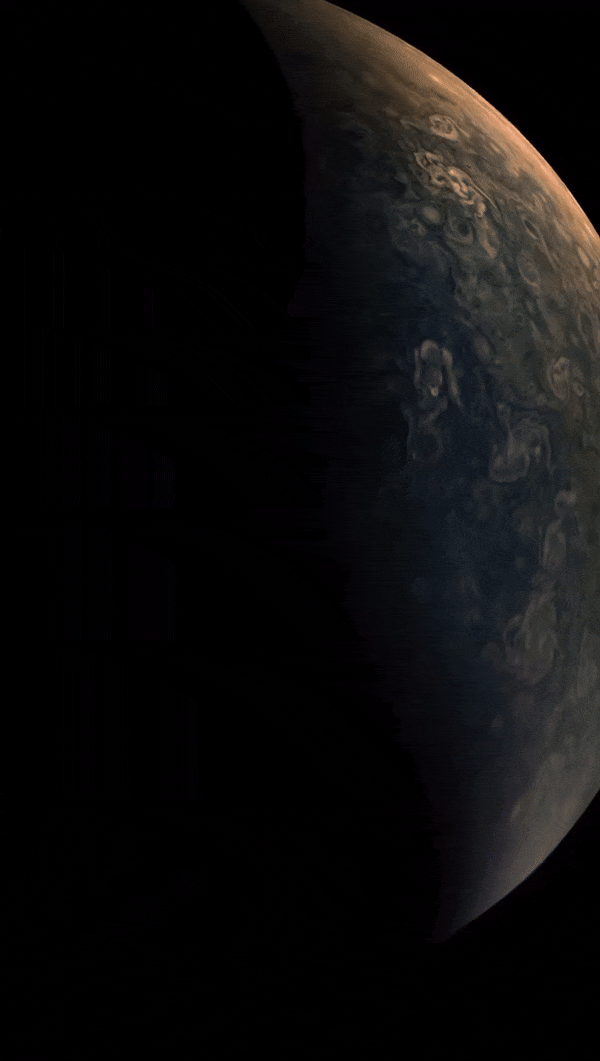
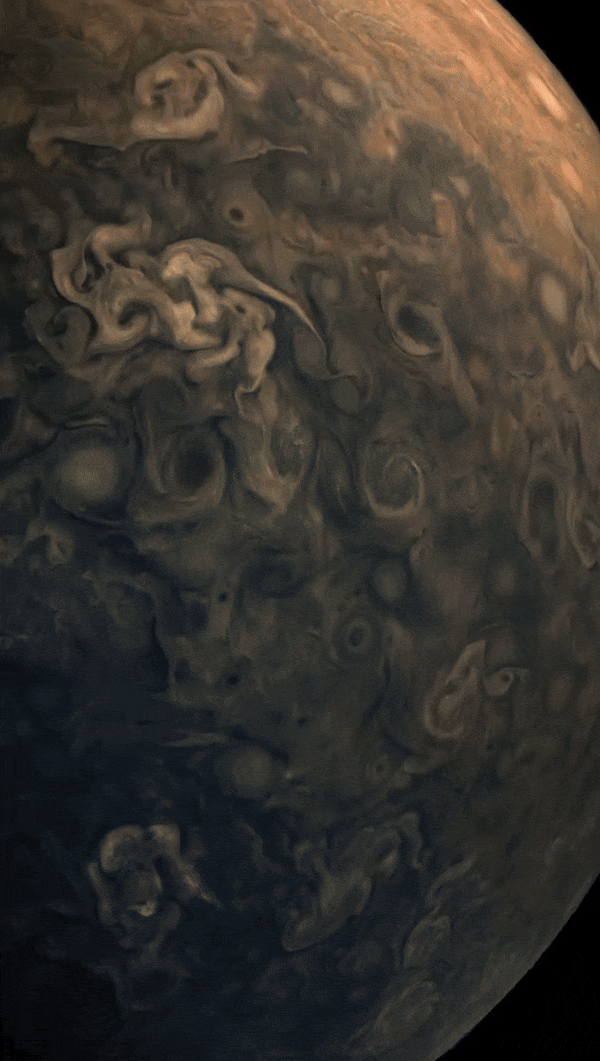



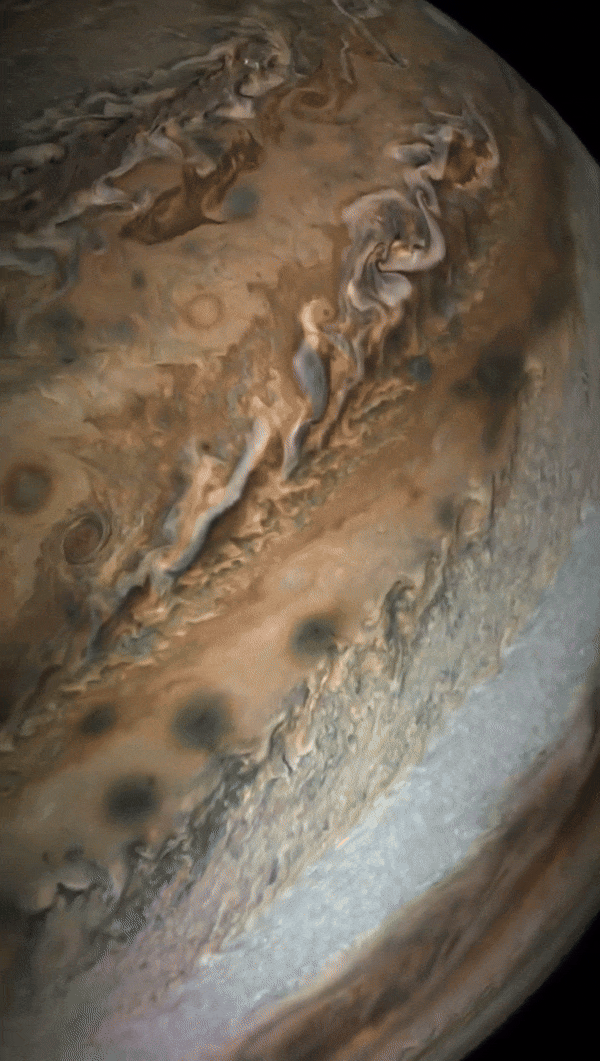
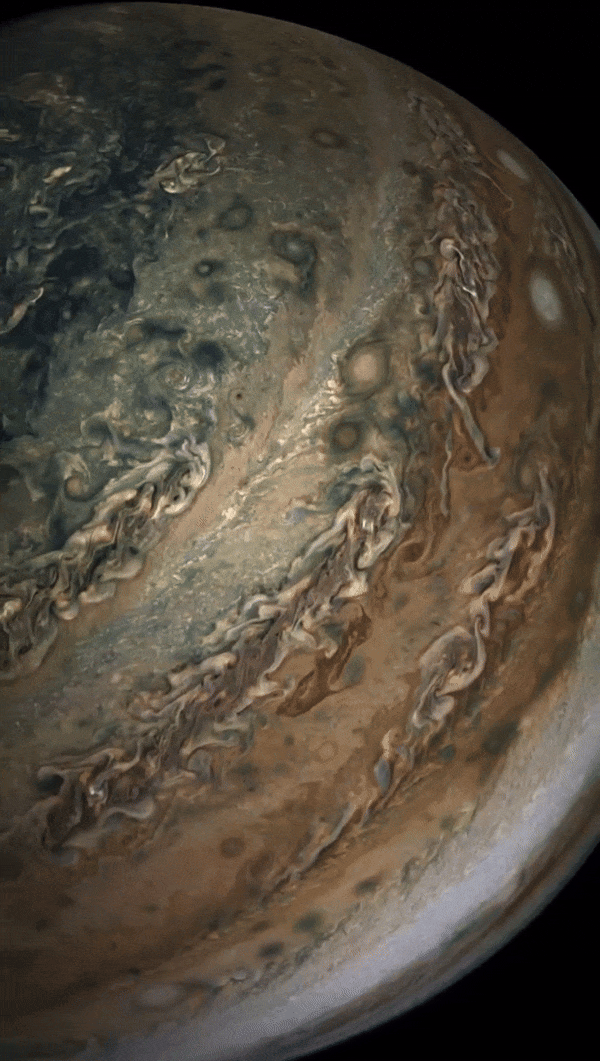

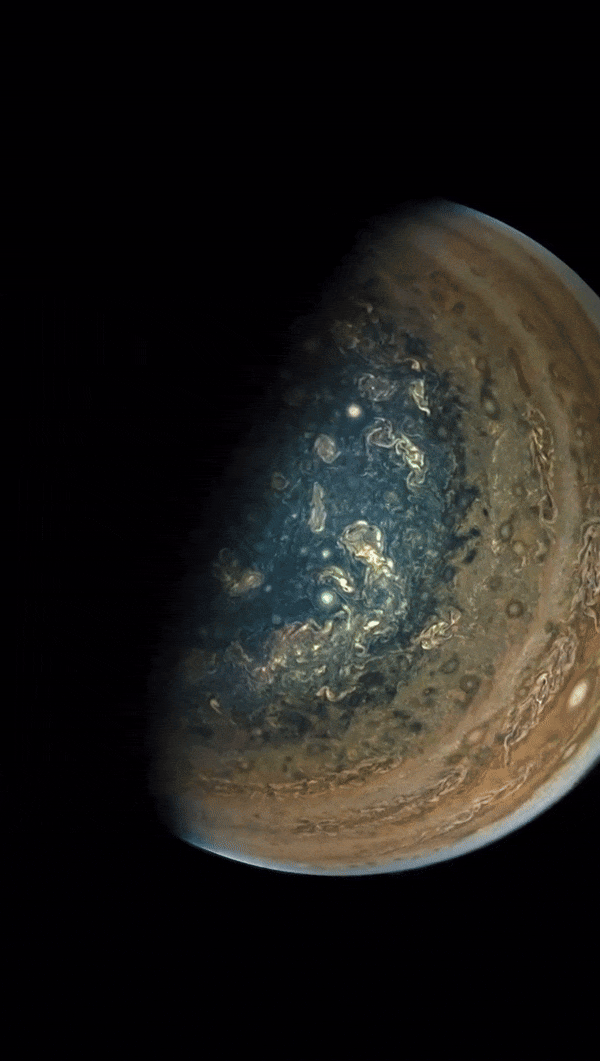
Stunning images of Jupiter captured by the Juno spacecraft during a close flyby in October 2018. (credit: NASA/JPL-Caltech/SwRI/MSSS/Gerald Eichstädt)
393 notes
·
View notes
Text

High-altitude electrical storms on Jupiter
Juno's sensitive Stellar Reference Unit camera detected unusual lightning flashes on Jupiter's dark side during the spacecraft's close flybys of the planet
📷Image Credit: NASA/JPL-Caltech/SwRI/MSSS/Gerald Eichstädt
📷Image Addition Date: 2020-08-05
609 notes
·
View notes
Text

NASA's Juno mission had depicted high-altitude electrical storms on Jupiter during close flybys of the gas giant and detected unusual lightning flashes on Jupiter's dark side 🛰
📷: NASA/JPL-Caltech/SwRI/MSSS/Gerald Eichstädt/Heidi N. Becker/Koji Kuramura
4 notes
·
View notes
Text
A beautiful view of polar Jupiter
Júpiter Polar Haze en color falso
Publicado 1 de febrero de 2017
Esta vista en falso color de la neblina polar de Júpiter fue creada por el científico ciudadano Gerald Eichstädt utilizando datos del instrumento JunoCam en la nave espacial Juno de la NASA.
La imagen se tomó el 11 de diciembre de 2016 a las 2:30 p. m. PST (5:30 p. m. EST), cuando la nave espacial se encontraba a 459 000…

View On WordPress
0 notes
Photo
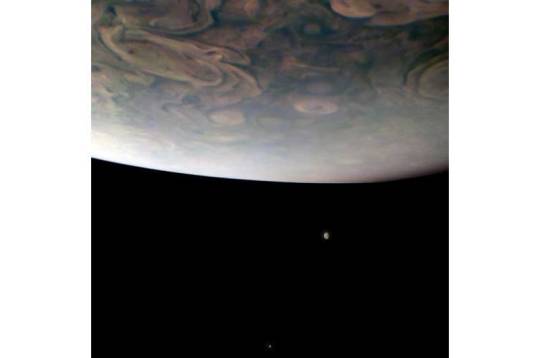
NASA's Juno mission spots two Jovian moons On Nov. 29, 2021, NASA's Juno mission completed its 38th close flyby of Jupiter. As the spacecraft sped low over the giant planet's cloud tops, its JunoCam instrument captured this look at two of Jupiter's largest moons. In the foreground, hurricane-like spiral wind patterns called vortices can be seen spinning in the planet's north polar region. These powerful storms can be over 30 miles (50 kilometers) in height and hundreds of miles across. Below Jupiter's curving horizon, two Jovian moons make an appearance: Callisto (below) and Io (above). Juno will make close flybys of Io in December 2023 and February 2024, the first such close encounters with this intriguing moon in over two decades. Io is the most volcanic body in our solar system, and its eruptions leave a trail of material behind that both fills Jupiter's magnetosphere and creates a torus of gas and dust around Jupiter. During the flybys, Juno will study Io's volcanoes and geology, search for signs of a magma ocean, and investigate how Io interacts with Jupiter's giant magnetosphere. Citizen scientist Gerald Eichstädt used raw JunoCam data to make the original version of this image, and then another citizen scientist, Thomas Thomopoulos, further processed it, zooming in and making color enhancements. In this view, north is down. At the time the image was taken, Juno was about 8,700 miles (14,000 kilometers) above Jupiter's cloud tops, at a latitude of about 69 degrees, traveling at a speed of about 123,000 mph (198,000 kilometers per hour) relative to the planet.
0 notes
Text
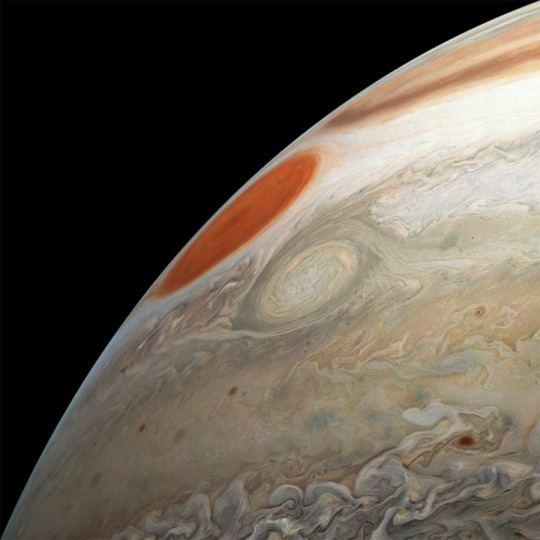
Twitter Credits:
NASA/JPL-Caltech/SwRI/MSSS/Gerald Eichstädt/@_TheSeaning
0 notes
Text
Publican primeras representaciones 3D de nubes de Júpiter tomadas por Juno
Publican primeras representaciones 3D de nubes de Júpiter tomadas por Juno
Las animaciones de las alturas relativas de las cimas de las nubes de Júpiter revelan remolinos y picos de textura delicada que se asemejan al glaseado en la parte superior de una magdalena. Los resultados han sido presentados hoy por el científico ciudadano y matemático profesional y desarrollador de software, Gerald Eichstädt, en el Europlanet Science Congress (EPSC) 2022 en Granada.
La…
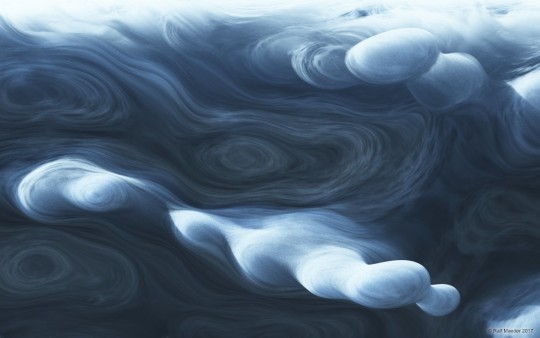
View On WordPress
0 notes
Text
First 3D renders from JunoCam data reveal 'frosted cupcake' clouds on Jupiter
First 3D renders from JunoCam data reveal ‘frosted cupcake’ clouds on Jupiter
Animations of the relative heights of the cloud tops of Jupiter reveal delicately textured swirls and peaks that resemble the frosting on top of a cupcake. The results have been presented today by citizen scientist and professional mathematician and software developer, Gerald Eichstädt, at the Europlanet Science Congress (EPSC) 2022 in Granada.
View On WordPress
0 notes
Photo


The tempests of Jupiter visualized by Kevin M. Gill (top) and Gerald Eichstädt, Heidi N. Becker, and Koji Kuramura (bottom) based on data from the Juno space probe. Click the source link to learn more.
#jupiter#juno mission#koji kuramura#heidi n becker#gerald eichstädt#kevin m gill#astronomy#gas giant#lightning
164 notes
·
View notes
Photo

Gerald Eichstädt and Seán Doran, using data from the JunoCam imager on NASA’s Juno spacecraft.
100 notes
·
View notes
Video
kaos ve tanrının bilmem kaçıncı eseri.
#NASA / SwRI / MSSS / Gerald Eichstädt / Seán Doran#benimpost#NASA#junocam#nasa juno#juno#jupiter#jupitor flyby
85 notes
·
View notes
Photo

Dark vortex of Jupiter. Credit: NASA/JPL-Caltech/SwRI/MSSS/Gerald Eichstädt/Seán Doran via /r/spaceporn https://ift.tt/2p0sNeq
1 note
·
View note
Text
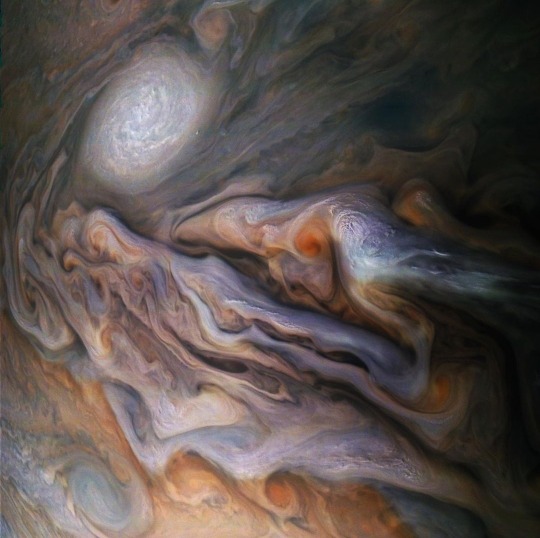
It's a latte bigger than Earth. ☕
This picture isn’t from your local coffee shop, it’s from our spacecraft Juno as it passed by Jupiter. Jupiter is well known for its Great Red Spot, but it’s also home to anticyclonic storms, known as white ovals. White oval’s can be storms the size of earth and can generate winds up to 335 miles per hour (539 kilometers per hour) and some storms can reach 60 miles (100 kilometers) tall.
Jupiter is strapped with “belts” of white and red, that wrap around the planet. Traveling both east and west, why these belts are distinct is something mystery to scientists, one possibility is that the ammonia gas in the atmosphere travels up and down in alignment with the planets jet streams.
Juno’s prime mission of measuring and studying Jupiter’s atmosphere and magnetic structure was completed in 2021, but it will continue to measure the planet’s unique structure until at least 2025. This image was color enhanced by citizen scientists Gerald Eichstädt and Sean Doran.
Credit: Enhanced Image by Gerald Eichstädt and Sean Doran (CC BY-NC-SA)/NASA/JPL-Caltech/SwRI/MSSS)
#nasa#jupiter#NASA#astrophotograpy#Juno#space#JunoCam#MissionJuno#storm#clouds#planet#planets#solar system#gassy
224 notes
·
View notes
Photo

Clouds swirling in the coffee colored atmosphere of Jupiter, looks more like a familiar morning beverage of champions.
This image from our Juno spacecraft was captured in North North Temperate Belt.
Image Credit: Enhanced Image by Gerald Eichstädt and Sean Doran (CC BY-NC-SA)/NASA/JPL-Caltech/SwRI/MSSS
Make sure to follow us on Tumblr for your regular dose of space: http://nasa.tumblr.com
#NASA#space#science#solar system#Jupiter#Juno#coffee#calm#calming#space pictures#space background#hazyview
7K notes
·
View notes
Photo

Jupiter's Great Red Spot from Juno (detail)
JUPITER'S GREAT RED SPOT FROM JUNO (DETAIL) Juno captured this view of Jupiter's Great Red Spot during its seventh perijove flyby on July 11, 2017 from an altitude of 9866 km. This flyby took Juno closer to the Great Red Spot than any previous mission to Jupiter. NASA / SwRI / MSSS / Gerald Eichstädt / Seán Doran
54 notes
·
View notes
Video
youtube
2021 October 11
Juno Flyby of Ganymede and Jupiter
Video Credit: Images: NASA, JPL-Caltech, SWRI, MSSS;
Animation: Koji Kuramura, Gerald Eichstädt, Mike Stetson; Music: Vangelis
Explanation: What would it be like to fly over the largest moon in the Solar System? In June, the robotic Juno spacecraft flew past Jupiter's huge moon Ganymede and took images that have been digitally constructed into a detailed flyby. As the featured video begins, Juno swoops over the two-toned surface of the 2,000-km wide moon, revealing an icy alien landscape filled with grooves and craters. The grooves are likely caused by shifting surface plates, while the craters are caused by violent impacts. Continuing on in its orbit, Juno then performed its 34th close pass over Jupiter's clouds. The digitally-constructed video shows numerous swirling clouds in the north, colorful planet-circling zones and bands across the middle -- featuring several white-oval clouds from the String of Pearls, and finally more swirling clouds in the south. Next September, Juno is scheduled to make a close pass over another of Jupiter's large moons: Europa.
∞ Source: apod.nasa.gov/apod/ap211011.html
50 notes
·
View notes